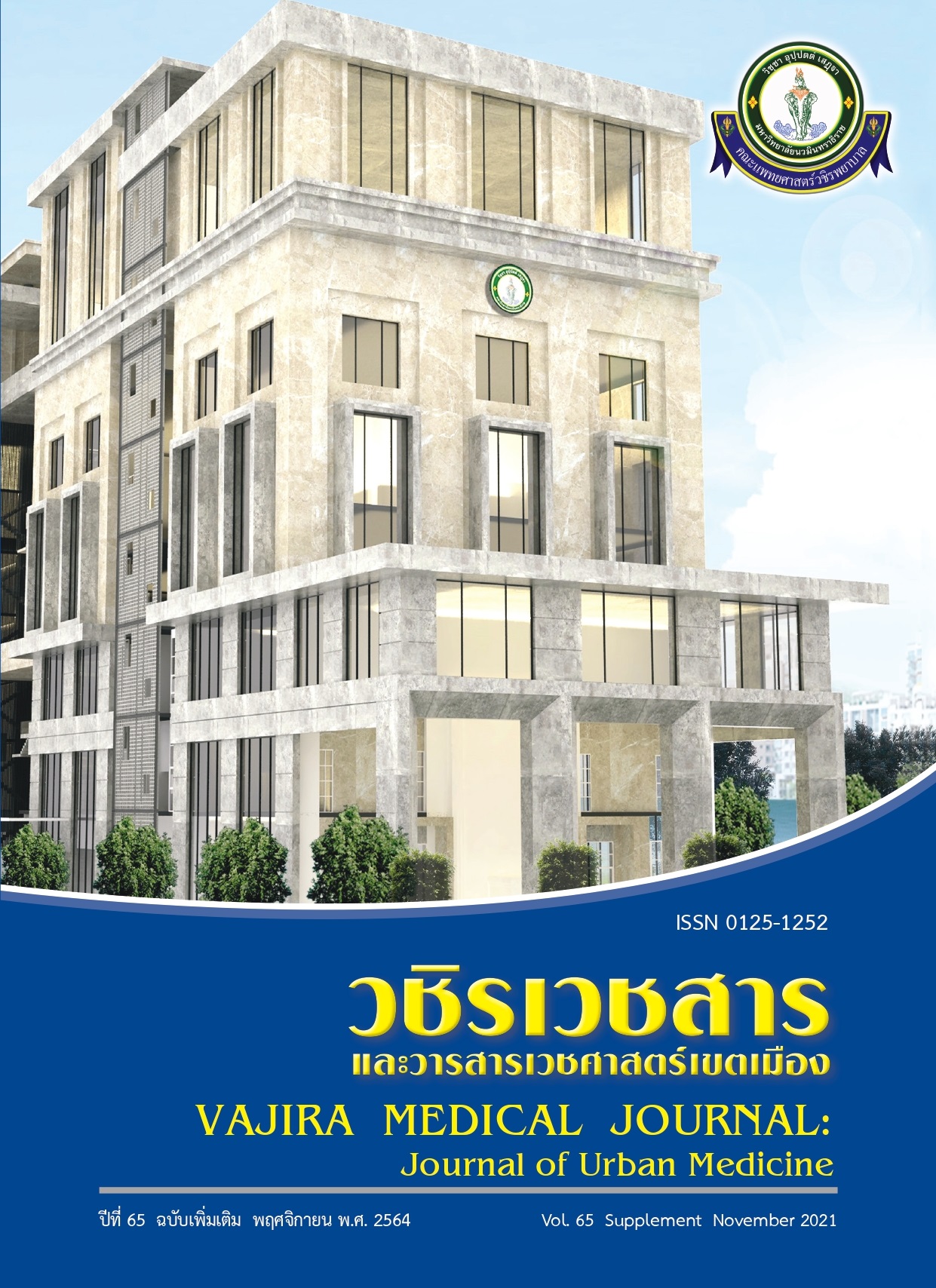Prevalence and Risk Factors of Chloroquine and Hydroxychloroquine Retinopathy
Main Article Content
Abstract
Objective: To evaluate the prevalence and risk factors of chloroquine and hydroxychloroquine retinopathy.
Methods: Retrospective cohort study was conducted at Vajira hospital. Medical records of autoimmune patients who received chloroquine and hydroxychloroquine from January 2017 to December 2019 were reviewed.
Results: Of the 177 enrolled patients, 19 patients developed retinopathy. The prevalence of chloroquine and hydroxychloroquine retinopathy was 10.7%. 17 patients had the pericentral pattern of retinal change, whereas only 2 patients had the classic parafoveal distribution of retinal damage. Factors associated with retinopathy were duration of chloroquine treatment (p=0.009), cumulative dose of chloroquine (p=0.009) and cumulative dose of chloroquine with hydroxychloroquine (p=0.015). After using multivariate analysis, duration of chloroquine treatment (adjusted OR=1.01; 95%CI 1.00-1.02, p=0.01) and liver disease (adjusted OR=23.72; 95%CI 1.25-448.68, p=0.035) were significant.
Conclusions: The prevalence of chloroquine and hydroxychloroquine retinopathy was 10.7%. Factors associated with retinopathy were duration of chloroquine treatment and liver disease. Factors that may associated with retinopathy were cumulative dose of chloroquine, cumulative dose of chloroquine with hydroxychloroquine.
Downloads
Article Details

This work is licensed under a Creative Commons Attribution-NonCommercial-NoDerivatives 4.0 International License.
References
Kurathong S. What's New in “Hydroxychloroquine Retinopathy”. Vajira Med J 2018;62:53-62.
Suansilpong A, Uaratanawong S. Accuracy of Amsler grid in screening for chloroquine retinopathy. J Med Assoc Thai. 2010;93(4):462-6.
Thongsin S. Chloroquine maculopathy in Chiang Rai Regional Hospital. Lampang Med J 2010;31(3):98-103.
Samsen P, Ruangvoravate N, Chiemchaisri Y, Parivisutti L. Chloroquine keratopathy. Thai J Ophthalmol 1995;9:167-73.
Srikua U, Aui-Aree N. Timing of chloroquine and hydroxychloroquine screening. Thai J Ophthalmol 2008;22:61-8.
Leecharoen S, Wangkaew S, Louthrenoo W. Ocular side effects of chloroquine in patients with rheumatoid arthritis, systemic lupus erythematosus and scleroderma. J Med Assoc Thai 2007;90:52-8.
Puavilai S, Kunavisarut S, Vatanasuk M, Timpatanapong P, Sriwong ST, Janwitayanujit S, et al. Ocular toxicity of chloroquine among Thai patients. Int J Dermatol 1999;38(12):934-7.
Chiowchanwisawakit P, Nilganuwong S, Srinonprasert V, Boonprasert R, Chandranipapongse W, Chatsiricharoenkul S, et al. Prevalence and risk factors for chloroquine maculopathy and role of plasma chloroquine and desethylchloroquine concentrations in predicting chloroquine maculopathy. Int J Rheum Dis 2013;16:47-55.
Tangtavorn N, Yospaiboon Y, Ratanapakorn T, Sinawat S, Sanguansak T, Bhoomibunchoo C, et al. Incidence of and risk factors for chloroquine and hydroxychloroquine retinopathy in Thai rheumatologic patients. Clin Ophthalmol 2016;10:2179-85.
Marmor MF, Kellner U, Lai TY, Lyon JS, Mieler WF. Revised recommendations on screening for chloroquine and hydroxychloroquine retinopathy. Ophthalmology 2011;118(2):415-22.
Marmor MF, Kellner U, Lai TY, Melles RB, Mieler WF. Recommendations on Screening for Chloroquine and Hydroxychloroquine Retinopathy (2016 Revision). Ophthalmology 2016;123(6):1386-94
McChesney EW. Animal toxicity and pharmacokinetics of hydroxychloroquine sulfate. Am J Med 1983;75:11-8.
El Shishtawy MA, Hassan KH, Ramzy R, Berri F, Mortada M, Nasreddine S, et al. Comparative to xicity study of chloroquine and hydroxychloroquine on adult albino rats. Eur Sci J 2015;Suppl 1:399–407.
Melles RB, Marmor MF. Pericentral retinopathy and racial differences in hydroxychloroquine toxicity. Ophthalmology 2015;122:110-6.
Mititelu M, Wong BJ, Brenner M, Bryar PJ, Jampol LM, Fawzi AA. Progression of Hydroxychloroquine Toxic Effects After Drug Therapy Cessation: New Evidence From Multimodal Imaging. JAMA Ophthalmol 2013;131(9):1187–97.
Marmor MF, Hu J. Effect of disease stage on progression of hydroxychloroquine retinopathy. JAMA Ophthalmol 2014;132(9):1105-12.


